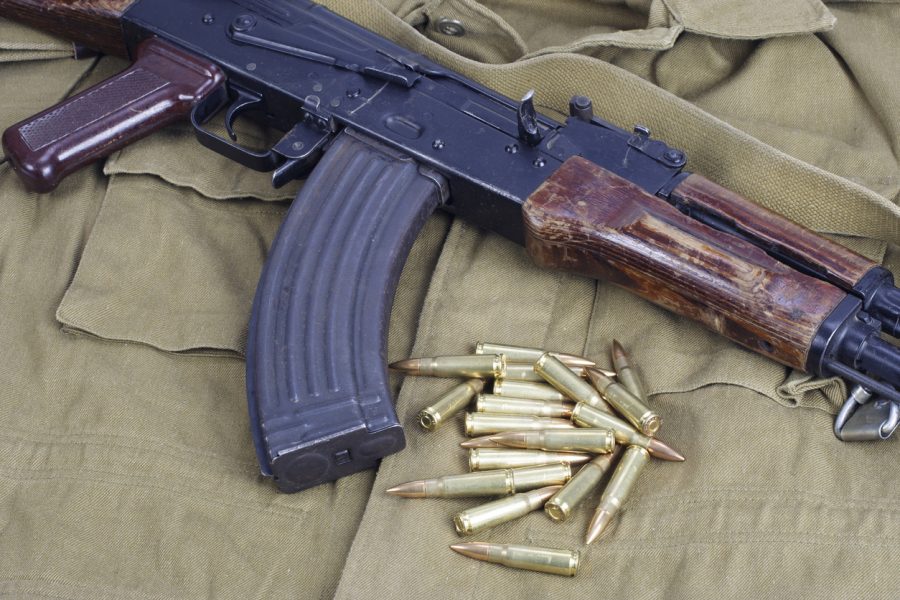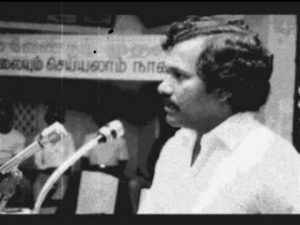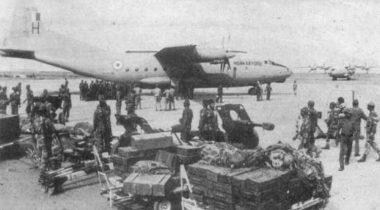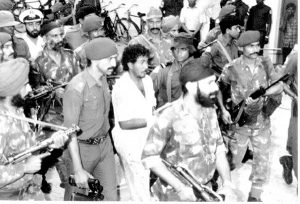
How a Lankan Tamil tried to capture Maldives and India beat him back
Uma Maheswaran, leader of Sri Lankan militant group PLOTE, dispatched nearly 80 armed mercenaries to launch an operation to remove the Maldivian president

There is a Maldivian legend about a Sri Lankan prince named Koi Malé who was marooned in a Maldivian lagoon with his wife, the daughter of a Sinhalese king. Koimale went on to rule the country as its first Sultan in the 12th century AD. It was as if this legend was sought to be re-enacted 800 years later by Uma Maheswaran, leader of Sri Lankan militant group PLOTE, who dispatched nearly 80 armed PLOTE mercenaries to launch an operation to remove the Maldivian president in a coup. The daring operation came unstuck because India came to the rescue of the beleaguered President Gayoom, unleashing attacks from the air, ground and at sea.

In the wee hours of November 3, 1988, 80 well-trained PLOTE militant cadres armed with AK-47s, grenades, heavy machine guns and mortars sailed off the Mulaithivu shores of Eastern Sri Lanka, as per the orders of PLOTE leader Uma Maheswaran, to help a group of Maldivians led by businessman Abdullah Luthufi overthrow the government of President Gayoom in the island republic of Maldives. The coup was foiled by the intervention of the Indian Army, code-named Operation Cactus. It began with the air-dropping of Indian soldiers by parachutes and ended with a naval battle on the high seas.
The 1,400-strong National Security contingent [NSS] of the Maldives was not like a regular army team, and was easily overrun by the PLOTE militants, by killing a few guards and taking over the complex. They went on to capture the power supply units, harbour, TV and radio stations—all within a few hours. The main installation was brought under them. They took full control of the one and a half square km-island, Male, with a population of 35,000 people, probably the smallest capital city in the world. A walk around the island takes less than an hour.
However, the well-planned operation failed for two reasons — the militants under a PLOTE leader, Vasanthi, failed to secure the telecommunications facility and President Maumoon Abdul Gayoom escaped unhurt. PLOTE militants later said the weapon of stealth was lost when some of Vasanthi’s men fired at a barrack, while others said the group was spotted by a group of policemen and immigration officials who attempted to stop them.
One of the PLOTE cadres fired in their direction — the officers cut and ran. However, the firing alerted the military and when the attackers arrived at the camp, the now alerted soldiers fired at the militants, killing Vasanthi among others. The PLOTE militants lost their leader and the weapon of surprise. A second setback came when they found the telecom facility closed — it was a holiday. The closed steel doors were able to withstand the explosive charges that the militants used. Hence, Gayoom was later able to contact world powers including India seeking help.
It was a chilly morning in Patna when the-then Prime Minister Rajiv Gandhi, who was touring the city on official business, received a call from his PMO. Ronen Sen, the then Joint Secretary in his PMO, informed that the Ministry of External Affairs just received an SOS from the Maldivian president asking India’s help to rescue him from an attempted coup.
Quick and decisive response from Indian government

Rajiv Gandhi gave the go-ahead for the rescue operation. New Delhi responded to the crisis with uncharacteristic speed and decision. The IAF airlifted some 300 paratroops from Agra to Malé, landing on the nearby island of Hulhule. Additional Indian troops were transported by air and by sea from Kochi and IAF Mirages were deployed over Malé as a show of force. The Indian paratroopers immediately secured the airfield, crossed over to Malé using commandeered boats, took control of Malé within several hours and rescued President Gayoom.
“We had no maps or naval charts. It was literally like flying in the dark,” pointed out Squadron leader A K Chordia later. It was a daring operation as there was virtually no intelligence available about the situation on the ground, he added.
It was 11:30 PM when the paratroopers landed in Hulhule. In the first wave, around 200 of Indian paratroopers had arrived, subsequently, 1,000 more entered the country.
The Indian troops went from Hulhule to Male on a boat and secured the President inside the National Security Services building in the capital.
The duty-free shops were looted by PLOTE at gunpoint before they got away grabbing 27 Maldivian hostages. PLOTE militants hijacked a ship named ‘Progress Light’ and sailed away leaving behind the bodies of 19 colleagues. Then began a naval battle.
Present in the motley group of hostages was a Maldivian cabinet minister and his relative (some said it was his mother-in-law). As the hijacked ship moved out of Male harbour, a high-speed Indian Navy Task Force led by the naval ship, INS Godavari, and with Captain Gopalachari in command, was fast closing in.
In the Navy war room in Delhi, monitoring every move there was Prime Minister Rajiv Gandhi!
In the wake of shockwaves created by grenades that INS Godavari’s helicopter dropped in the ocean around MV Progress Light, the frigates launched a powerful strike against the freighter. The violent confrontation between the cargo ship and the frigates resulted in the deaths of a number of mercenaries and three hostages.

The rebel leader Luthifi who was on board Progress Light told the Island in an interview in 2012, “We refused to give in. We demanded mid-sea negotiations to settle the dispute. The Indians started firing at our ship at the behest of the Maldivians onboard their vessel. The PLOTE commander got in touch with their headquarters in Sri Lanka and sought instructions. They received instructions to execute one hostage and throw his body to the sea. In spite of the Maldivian minister in captivity making a desperate bid to avoid the execution of one of the hostages, the PLOTE took one person to the deck and shot him. They threw the body and the Indians recovered it. The remaining hostages volunteered to come on the main deck in a bid to discourage the Indians from firing at us. But the Maldivians onboard the Indian warship wanted all of us killed.”
“On the morning of November 6, they fired at our ship and gave us three hours to surrender without any preconditions or face the consequences. We didn’t stop but proceeded towards Sri Lankan waters. We were about 30 nautical miles away from our position when the Indians opened up with big guns. The minister was among the persons hit during the initial fire. We didn’t fire back as Indian ships were out of the range of our guns. I directed the Filipino engineer to stop the engine. As I was watching him ‘killing’ the engine, he was hit. We were ordered to jump into the sea and were rescued by the Indians immediately after we raised a white flag,” Luthifi told the Island.
The Indian camp was relieved when the operation ended. “Hostages rescued safely and rebels captured” was the final message from INS Godavari that brought down the curtain on Operation Cactus.
A rival of Prabakaran
Abdullah Luthufi was a Maldivian businessman who ran a poultry farm in Sri Lanka. Mukundan alias Uma Maheswaran, a former Land Surveyor, was trained in Guerilla warfare under PLO in Syria and Lebanon, and was a former leader of the LTTE from 1977 to 1980 till he fell out and formed the PLOTE. The conspiracy was hatched in Bambalapitiya.
LTTE leader Prabhakaran began to eliminate his rivals while the arrival of IPKF (Indian Peace Keeping Force), as part of the Indo-Lanka accord, provided Maheswaran little space to operate. Maheshwaran was desperately looking for options, and Luthifi’s plan came as a great opportunity to probably establish a base for PLOTE on one of the islands, where PLOTE militants could store weapons, and also try and announce a Tamil Eelam government in exile.
Kadirgamapillai Nallainathan later came to be known as Mukundan alias Uma Maheswaran. After he fell out with LTTE leader Prabakaran, he shifted his base in the early eighties to Chennai, where too lived the leaders of the other militant groups like Sabaratnam (TELO), Prabakaran (LTTE), Padamanbha (EPRLF) and Balakumar (EROS). The MGR government in Tamil Nadu had allowed them to operate out of Chennai but each group was assigned a specific zone and asked not to stray into the zone earmarked for another group.
However, on May 19, 1982, a shootout occurred at Pondy Bazaar in Chennai between LTTE and PLOTE members. Prabakaran and Raghavan (alias Sivakumar) of the LTTE, armed with revolvers, fired at Jotheeswaran and Mukundan (alias Uma Maheswaran) of the PLOTE. The two groups were said to have exchanged fire.
Jotheeswaran is said to have sustained bullet injuries in his thighs. Mukundan was also shot at but escaped unhurt. Prabakaran and Sivakumar were arrested and remanded to custody.
Maheswaran was arrested near Gummidipoondi railway station inTamil Nadu on May 25, 1982 after a shoot-out with the police but was later released on bail.
Maheswaran and PLOTE were alleged to have carried out bank robberies and kidnappings to finance their activities. His actions led to divisions within PLOTE and a number of splinter groups were formed including the Eelam National Democratic Liberation Front (ENDLF). Maheswaran is said to have dealt harshly with dissidence and was also alleged to have carried out 38 murders to crush rebellion.
On 16 July 1989, Maheswaran was abducted by six men in Colombo. His bullet-ridden body was later found on Frankfurt Place, Bambalapitiya, ironically enough, near the Maldivian High Commission. The ENDLF claimed responsibility for the assassination. Some others blamed the assassination on disgruntled members of PLOTE.

